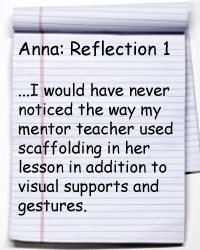 Gestures & Visuals in the SL/FL Classroom
Gestures & Visuals in the SL/FL Classroom

In this scenario Anna has discovered how powerful an impact visuals and gestures can have in the second language classroom. She has seen her mentor teacher using them with beginners and witnessed the difference it makes in comprehension. Why are these techniques so effective? By using visuals and gestures Anna sees that her mentor teacher is able to create context for her students. This context provides a foundation on which to build understanding of the language while at the same time connecting the information to something the students already know. In this section we will discuss how context can be created in the SL classroom. |
back to case study |
Why is it important to create context?
Memory and understanding are key aspects of being able to learn, retain and use a language. The question that arises from this, however, is how can we enhance memory and understanding. One way in which this can be done is through the creation of meaningful context. By creating context students are able to link what they are learning to previous knowledge or experiences while at the same time make new connections in their brain which can later stimulate memory. The question now is: what makes context 'meaningful'?
What makes context meaningful for my students?
The main idea to remember about creating meaningful context is that it varies from learner to learner. What might be important to one learner can be completely irrelevant for another. In her article “Cognition, Context, and Computers: Factors in Effective Foreign Language Learning” Judith Frommer suggests a multi-leveled framework to better define the idea of context in teaching a language. This framework can help us to better understand how to make context meaningful.
Level |
Description |
Ideas for the Classroom |
| Words in context | If words are to be remembered they must be presented in meaningful contexts where the engagement of students in an activity depends highly on their knowledge of background and context. | When presenting vocabulary:
|
| Discourse context | The use of words in authentic or instrumental sentences and situations. |
Ask referential questions (those to which only the respondent knows the answer) Use authentic situations to practice language functions |
| Target Culture context | Information about the specific target culture that can help to create more meaning for learners. | Demonstrate cultural differences through examples (i.e. buying bread in France does not have the same cultural implications as buying bread in North America) |
| Individual Learner context | What each individual learner brings to the lesson including personal experiences, cultural background, exposure to different ways of thinking and personal beliefs. | Get to know the students in order to incorporate their interests and experiences in the lesson Offer students choice when planning activities |
back to top
How can I create context in my lessons?
Now that we know why context is important and how we can think about making it meaningful for individual students let's look at some ways to create context in the classroom.
 |
Watch the video and watch for different ways that these teachers try to create context in their lessons. click image to begin playback (2:20) |
Gestures
Using gestures does not mean ‘talking with your hands’ or ‘gesturing’ while speaking. Gestures in the second language-learning context need to act as visual cues as to what the speaker is talking about. For example; waving to signal hello, pointing to the object one is talking about, holding one’s hands to look like they are steering a car while talking about driving, etc. Think for a moment about how you would explain ‘eat’ to someone when neither of you speak any similar language. Now think about why you would choose that action and whether or not someone from any culture could understand it. Would your gesture be considered useful?
Visuals
Useful visuals can include things like picture prompts and pictures of the items one is speaking about. Think about visual dictionaries and how children learn to read with simple picture books; these pictures help the reader to understand the meaning of the words. The visuals must be clear, obvious and directly associated with the words.
Storytelling and Anecdotes
Storytelling can be a very powerful tool in creating context. Not only are stories and anecdotes entertaining, but they can help to activate prior knowledge in a learner or create new connection that may help a learner to remember.
 |
Creating context is an important part of GIVING IT. Come up with a context that you would use to present new vocabulary for each of the following topics. Example: Fruits and Vegetables- A cooking show 1. Sports and Games 2. Body parts 3. Family members |










